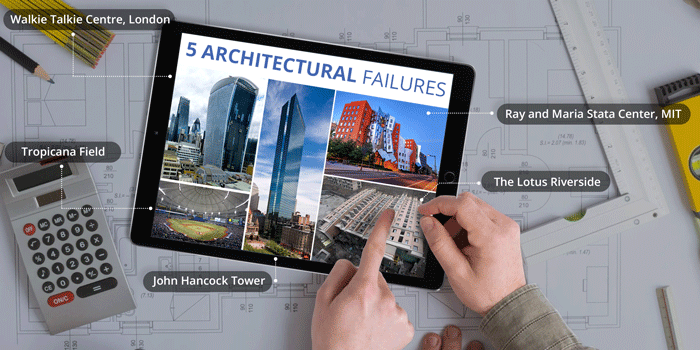Throughout the ages, there have been numerous architectural marvels and wonders. From the Sydney Opera House to Frank Lloyd Wright’s Falling Water, architecture has intrigued and enthralled us. But, for every masterpiece, there is an epic fail.
The most famous example of architecture gone bad is the Leaning Tower of Pisa. Beloved by tourists, this bell tower has been tilting since construction began. Not counting this obvious example, we dive into five of our favorite failures, and a couple honorable mentions, to see if they could have been saved.
John Hancock Tower
The tallest building in Boston, the John Hancock Tower, acts as a navigational landmark for many. This 60-story building was completed in 1976 and was the winner of the prestigious National Honor Award from the American Institute of Architects in 1977. However, the building has a dubious past.
The Embarrassing Failure:
This building makes our list for it’s glass window panes falling out and crashing onto the pavement below. In January 1973 over 60 windows fell due to a windstorm. This led to all the windows being replaced by plywood, a very unattractive look to Bostonians who often joked about the building calling it the “Plywood Palace.” Eventually, all 10,000 windows were replaced at a cost of $5 million.
The building’s troubles didn’t end there. Skyscrapers are meant to sway to absorb strong gusts of wind, though the sway is not detectable by the building’s residents. The Hancock, however, swayed so dramatically that it gave the occupants of its upper floors motion sickness. The issue was eventually fixed much to the relief of the workers.
Honorable mention in the Glass Falling Category: CNA Center, Chicago. This building make HM not only because it also had large glass windows falling, but mostly because it is painted bright red.
The Lotus Riverside
The Lotus Riverside is a complex of 11 apartment buildings in Shanghai. In June 2009, with half of the units already sold, workers arrived to work one morning to find one of the buildings had fallen flat on its side. What remains most intriguing fact is that it remained mostly intact.
The Embarrassing Failure:
Unfortunately, there was one fatality. However, when it collapsed, the building just missed falling onto an adjacent building, which would have created a devastating domino effect. Pressure to meet deadlines and errors in construction procedures, most notably the excavation for an underground parking garage, led to the project’s demise. Eventually, six officials of the real estate firm responsible were found guilty of numerous charges related to the collapse.
Ray and Maria Stata Center, MIT
This building, which houses MIT’s Computer Science and Artificial Intelligence Labs, Department of Linguistics and Philosophy and the Laboratory of Information and Decision Systems, opened to much fanfare in 2004. Designed by an award winning architect Frank Gehry, it received acclaim for its daring design of random curves and angles, and was said to defy the laws of physics.
The Embarrassing Failure:
Three years after it opened, the honeymoon was over. MIT filed a negligence suit claiming design flaws had major structural issues leading to leaks, cracks, drainage backups, mold and even dangerous icicles in the winter. Eventually, MIT spent more than $1.5 million on repairs.
Tropicana Field
The home of the MLB Tampa Bay Rays, located in St. Petersburg, Florida, is currently not only the last non-retractable domed stadium in Major League Baseball, but also considered small and bland. But what puts this on our list is the building’s ability to affect the game. To be specific, the unfortunate catwalks get in the way of balls..
The Embarrassing Failure:
Considering the fact that the venue was built to house a MLB team, including catwalks that hang directly over the outfield in the design is astonishing. Given that it’s baseball, one would think it’s important not to place obstacles in potential ball trajectories the obstruction has created interesting ground rules and affected the outcome of several games. Adding insult to injury is the rare occasion where a ball hits a light bulb, and glass rains down on the field. With all these issues, it’s no wonder The Trop landed in last place in the countdown of major league parks by USA Today in 2013.
Walkie Talkie Centre, London
An award winning skyscraper, 20 Fenchurch Street in the center of London, is also known as “Walkie Talkie Centre” due to its concave design. This 34-story building is the 6th tallest building in London, however, since it’s design phase, it has faced controversy. In addition to concerns from heritage group (regarding the modern design), creating a slight wind tunnel effect and criticism of the sky garden, this one makes our list from the windows acting like a mirror and focusing sunlight onto local streets.
The Embarrassing Failure:
The problem was so bad, it led to temperatures reaching up to 196° F, damaging cars and leading to scorched door mats of nearby buildings. One local newspaper even tested the old cliché to see if it heated the ground hot enough to fry an egg (it did). It’s no wonder that in 2015 it was awarded the Carbuncle Cup for the worst new building in the UK.
Honorable mention in the Overheated Reflector Category: the Vdara Hotel in Las Vegas, which had the same sunlight reflection issue that employees dubbed “Vdara Death Ray.” Not surprisingly it was designed by the same architect.
What could have saved these failures?
In hindsight, all these failures could have been prevented with proper design and planning, following construction techniques, specified materials reviewed and establishing open communication channels. While some have unique circumstances, like the corruption surrounding the Lotus Riverside, the other epic failures seem to fall into three categories: design (Tropicana Field), engineering (John Hancock Tower) and communication.
In the case of communication issues, both the Walkie Talkie Centre and Stata Center at MIT suffered from poor communication. In the case of the Walkie Talkie Centre, the architect has said that sun-louvres had been intended to prevent this problem, however, they were removed at some point during the planning process without discussion.
As for the Stata Center in MIT, despite its flaws, flaws in the design could have been corrected during construction with proper communication. The construction company claimed they had warned the architect of the design issues on numerous occasions. However, they were told to proceed with the original designs. Had there been open communication and collaboration, this failure could have been averted.
Could today’s technology have saved these epic architectural failures? Not all of them, given some of the circumstances (corruption, egos). However, in the cases of the Walkie Talkie and Stata Center, using construction project management software providing clearer communication, accountability and documents that are always up-to-date could have made a difference.





